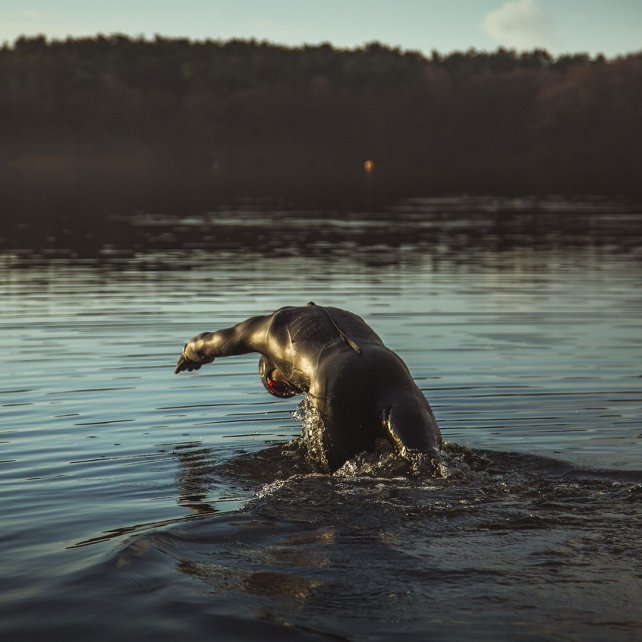Zone3 security first
By Dr Lis Kilcourse MBBS MRCGP, aka The Running Medic
This last year has seen a huge rise in the popularity of open water and cold-water swimming, and rightly so. There are many health benefits to open water swimming; and with the global coronavirus pandemic and lack of access to indoor leisure facilities, open water swimming has allowed many to get in the water when they may not otherwise have been able to. I have spoken about how much I have enjoyed the thrill of open water swimming. However, open water swimming, be it cold water swimming or otherwise does not come without risk. What this risk is and how big the risk is can depend on several things; you as a swimmer and your confidence in the water, how well you feel on a particular day, water temperature, pollution, and the type of water you are swimming in. Below are a few tips on how to stay safe in the open water.

What equipment do you need?
What equipment you need will depend very much on the temperature of the water; above 19C you may need nothing more than a swimsuit to swim in; temperatures less than that and most will want a wetsuit.
When it comes to cold water swimming, it is important to do and wear what feels right for you; you may see photos online of people in their swimsuits and bobble hats; or have hardy friends who want to do this, but if you don’t feel comfortable then wear a wetsuit. This includes a thermal wetsuit and or use neoprene base layers, gloves, socks, and a hat for extra warmth and to stop your hands and feet from getting cold. Zone3 have excellent versions of all of these which I use and personally find very helpful.

Of course, If you want to go for skins, the OW swimming term for wearing a swimsuit only, you can, it wouldn’t be for me, but many choose to get in the water that way. When we do swim in the open water, the body adapts by reducing blood supply to the skin so that our body fat provides an insulating layer against the cold, sometimes called “bioprene.”
Apart from the wetsuit itself, it is wise to have a tow float to make you more visible to others from the shore, a lot of organised swims will insist that you have a tow float before you get in for safety.
Ensure you have plenty of warm layers for when you get out of the water, parka robes are essential for keeping warm post-swim. Plus, it is always handy to have a thermos of warm tea for when you get out!
Before getting in the water
Before you get in the water there are a few things to consider.
Is the water safe?
Think about the pollution and currents that may be present; ensure there is a safe place to get in and out of the water. I would not swim alone so go with a friend or to an organised swim; Swim England has a list of places to open water swim.
How strong a swimmer are you?
If this is your first time going think about; how strong a swimmer you are; what are the water conditions, how acclimatised you are to the water, what is your endurance like and what are the weather conditions? Don’t forget that being strong in an indoor pool is different from being strong outside, so do consider that before you get in.
What temperature is the water?
Anything below 6C is freezing; below 12C is very cold; between 12 and 16C is chilly, from 16 to 20C is warm enough that some may feel comfortable without a wetsuit and above 20C is mild. In the UK, it takes until April for the water to get into double figures although this can vary depending on the winter; and it stays above 10C up until late October. In the summer it can get up to 20C but again this can vary depending on the weather.

When in the water
When you enter the water, do so slowly, because the initial change in temperature (cold shock), can cause you to hyperventilate. Your body will adapt to this with repeated exposure to cold water, 5-6 bouts of three minutes in cold water is enough to help adaptation but even so, it is important to respect the water and take it slowly. This is why it is important not to jump into the water, the shock can cause you to stop breathing.
Once in the water, you can experience cold incapacitation. This is when the blood flow to your limbs reduces, your muscles lose power, and swimming will become increasingly difficult. As you get cold, your body can sometimes start to feel warmer, which can in itself be a danger sign. Keep close to the edge and don’t be tempted to swim into the middle of the lake. Never feel pressured to do a certain distance or amount of time in the water, and don’t try to compare yourself to previous weeks. Accept that there will be some days when you can stay in longer and go further than others; this can vary depending on how tired you are or what the weather is like, just like any other workout. You might find that sometimes, you can only do a few strokes before you get out, which is fine. Quick cold water immersion for a few minutes is absolutely fine and good for your mental wellbeing if that is what feels comfortable on the day.

When to get out
Get out when you feel that you are starting to get cold. This might sound obvious but the mind can play tricks on you, if you stay in beyond feeling cold you can even start to feel warm again.
Once out the main risk is of aftershock. Aftershock is what happens as the body continues to cool after you have got out of the water, this happens because of the effect of conductive cooling and can last for up to 30 minutes. There are various things you can do to reduce the chance of this happening. First of all, dry off quickly, taking things off your top first, and then putting lots of layers on. Stand on something warm to avoid heat escaping from your feet and sip on something warm like a thermos of hot tea.
There is a risk, especially if the water is cold, but even when it is not, of developing hypothermia. Hypothermia is when the body temperature drops below 35C. Signs to watch out for of this are uncontrollable shivering, loss of coordination, hands becoming like claws, difficulty in how you speak, and weakness in your arms and legs. If you spot someone and think they have hypothermia or you feel you may be struggling yourself; get out of the water as quickly as possible. Remove all wet clothes, pat down dry, stay out of the wind and either lie or sit down. Put on lots of layers and have something warm to drink (no caffeine or alcohol) preferably with sugar. Get somewhere warm and if available a hot water bottle can be helpful. Be wary that hypothermia slows down how you think and you may not be aware of your condition when symptoms start.

This may sound like there are a lot of negatives to open water swimming, but there are so many positives to it as well. As with so many things it is about doing it safely and within your limits. So please, don’t let this all put you off! There is a lot of fun to be had outside in the water, just be safe while you are doing it.



















.jpg)



.jpg)



-01.png)









